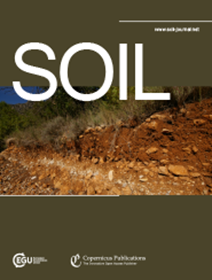Estimating soil organic carbon stocks in Pinus halepensis mill. stands using lidar data and field inventory
IF 4.3
2区 农林科学
Q1 SOIL SCIENCE
引用次数: 0
Abstract
Abstract. Accurate estimation of soil organic carbon (SOC) in forest ecosystems is essential for quantifying their contribution as carbon sinks and improving management strategies in the face of climate change. The objective of this study was to model SOC in Pinus halepensis Mill. stands using structural metrics derived from LiDAR data from the National Aerial Orthophotography Plan (PNOA). The study area covered 46.8 hectares located in the municipality of Ampudia, Palencia (Spain). To carry out the work, systematic soil sampling and a forest inventory were conducted. LiDAR technology was also applied and 87 structural metrics were obtained. These metrics were integrated with edaphic variables and above-ground biomass data to build predictive models of carbon stock using multivariate regression techniques. Among the models evaluated, the Random Forest algorithm showed the best performance in cross-validation (R² = 0.81; RMSE = 7.73 Mg/ha), demonstrating adequate predictive capacity compared to other models. The proposed approach made it possible to evaluate the potential of LiDAR data from airborne laser scanning (ALS), acquired within the framework of general mapping programmes, as an effective tool for the spatial estimation of SOC. This procedure, validated on an empirical basis, provides a useful methodological basis for advancing in the estimation of SOC through remote sensing, contributing to improve the quantification of soil-related ecosystem services.黑松林土壤有机碳储量估算。使用激光雷达数据和现场库存
摘要。准确估算森林生态系统土壤有机碳(SOC)对于量化其碳汇贡献和改善气候变化下的管理策略至关重要。本研究的目的是模拟halepensis Mill的SOC。使用来自国家航空正射影计划(PNOA)的激光雷达数据得出的结构度量。研究区占地46.8公顷,位于帕伦西亚(西班牙)的阿姆普迪亚市。为了开展这项工作,进行了系统的土壤取样和森林清查。应用激光雷达技术,获得了87个结构指标。将这些指标与土壤变量和地上生物量数据相结合,利用多元回归技术建立碳储量预测模型。其中,随机森林算法交叉验证效果最佳(R²= 0.81,RMSE = 7.73 Mg/ha),具有较强的预测能力。所提出的方法可以评估在一般制图程序框架内获得的机载激光扫描(ALS)激光雷达数据的潜力,作为SOC空间估计的有效工具。该方法经过实证验证,为推进土壤有机碳的遥感估算提供了有益的方法基础,有助于完善土壤生态系统服务的定量化。
本文章由计算机程序翻译,如有差异,请以英文原文为准。
求助全文
约1分钟内获得全文
求助全文
来源期刊

Soil
Agricultural and Biological Sciences-Soil Science
CiteScore
10.80
自引率
2.90%
发文量
44
审稿时长
30 weeks
期刊介绍:
SOIL is an international scientific journal dedicated to the publication and discussion of high-quality research in the field of soil system sciences.
SOIL is at the interface between the atmosphere, lithosphere, hydrosphere, and biosphere. SOIL publishes scientific research that contributes to understanding the soil system and its interaction with humans and the entire Earth system. The scope of the journal includes all topics that fall within the study of soil science as a discipline, with an emphasis on studies that integrate soil science with other sciences (hydrology, agronomy, socio-economics, health sciences, atmospheric sciences, etc.).
 求助内容:
求助内容: 应助结果提醒方式:
应助结果提醒方式:


